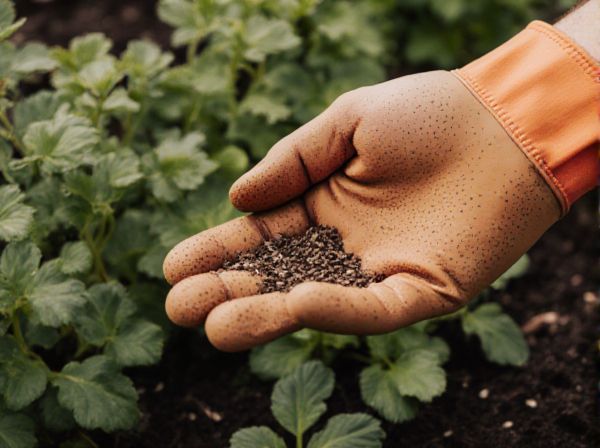
Dormant seeding vs Active seeding Illustration
Dormant seeding involves planting seeds during the late fall or winter when soil temperatures are low and plant growth is minimal, allowing seeds to germinate naturally as conditions improve in spring. Active seeding occurs in spring or early summer when soil and air temperatures are favorable for immediate seed germination and rapid plant establishment. Choosing between dormant and active seeding depends on climate, soil conditions, and the specific goals for vegetation growth and management.
Table of Comparison
| Aspect | Dormant Seeding | Active Seeding |
|---|---|---|
| Season Timing | Late fall to early spring (dormant period) | Spring to early summer (growing season) |
| Seed Germination | Occurs when soil warms after seeding | Immediate germination in warm soil |
| Soil Moisture | Relies on natural moisture and snow melt | Requires consistent irrigation or rainfall |
| Weed Competition | Minimal weed competition during dormant period | Higher weed competition during active growth |
| Risk of Seed Loss | Higher risk from frost heaving and wildlife | Lower risk due to controlled conditions |
| Optimal Use | Best for cool-season grasses and extending growing season | Best for warm-season grasses and rapid establishment |
Understanding Dormant Seeding in Gardening
Dormant seeding involves planting seeds during the season when they are naturally inactive, typically in late fall or early winter, allowing them to endure cold conditions before germination in spring. This method leverages natural stratification, enhancing seed viability and uniformity in sprouting by exposing seeds to necessary chilling periods. Gardening with dormant seeds minimizes early watering needs and protects young plants from late frosts, promoting healthier growth cycles.
What is Active Seeding?
Active seeding refers to the process of directly sowing seeds into prepared soil during a planting season, ensuring immediate germination and growth under favorable conditions. This method contrasts with dormant seeding, where seeds are planted during a dormant period and rely on natural cycles to initiate germination. Active seeding improves crop establishment rates by targeting optimal environmental factors such as temperature, moisture, and soil quality.
Key Differences Between Dormant and Active Seeding
Dormant seeding occurs during a plant's inactive growth phase, typically in late fall or winter, allowing seeds to establish roots without immediate shoot growth. Active seeding takes place in the active growing season, such as spring or early summer, promoting rapid germination and shoot development due to favorable temperature and moisture conditions. Key differences include timing, growth activity, and environmental requirements, with dormant seeding relying on natural stratification and active seeding depending on optimal growth conditions.
Optimal Timing for Dormant Seeding
Optimal timing for dormant seeding occurs during late fall to early winter, when the soil is still workable but plant growth has ceased. This period ensures seeds remain protected under soil cover, reducing erosion and moisture loss while allowing germination with the arrival of spring warmth. Dormant seeding during this window outperforms active seeding in establishing root systems before summer drought stress.
Best Practices for Active Seeding
Active seeding requires timely soil preparation and optimal moisture levels to maximize seed germination and growth during the growing season. Selecting high-quality, disease-resistant seed varieties and ensuring even seed distribution through calibrated equipment enhances crop uniformity and yield. Monitoring weather forecasts and applying appropriate fertilization immediately after seeding further support vigorous seedling development and reduce pest pressure.
Advantages of Dormant Seeding
Dormant seeding offers the advantage of improved germination rates due to soil moisture accumulation over winter, reducing the need for irrigation and enhancing seedling survival. This method minimizes weed competition and pest pressure by allowing seeds to establish before spring growth begins. Dormant seeding also enables earlier planting schedules, optimizing labor and equipment use during less busy periods.
Benefits of Active Seeding
Active seeding enhances crop establishment by ensuring faster germination and uniform growth compared to dormant seeding, which relies on natural conditions to trigger sprouting. This method allows for optimized nutrient uptake and better resistance to pests and diseases during early developmental stages. Farmers benefit from higher yields and more efficient land use by implementing active seeding strategies during the optimal planting season.
Challenges and Risks of Dormant Seeding
Dormant seeding faces challenges such as unpredictable weather patterns that can delay germination and reduce seed viability, increasing the risk of crop failure. Soil conditions during the dormant period may also lead to seed decay or pest infestation, compromising overall seedling emergence rates. Furthermore, the lack of immediate growth feedback complicates timely interventions, making dormant seeding a higher risk strategy compared to active seeding.
Common Mistakes in Dormant and Active Seeding
Common mistakes in dormant seeding include planting seeds too early or too late, leading to poor germination rates and uneven turf establishment. In active seeding, errors often arise from inadequate soil preparation and improper watering schedules, which cause seed desiccation or fungal diseases. Understanding optimal timing and proper field conditions enhances seedling success and turf density in both dormant and active seeding seasons.
Choosing the Right Seeding Method for Your Garden
Dormant seeding involves planting seeds during the fall or winter when they remain inactive until conditions become favorable, promoting natural stratification and reducing early weed competition. Active seeding is done in spring or early summer with seeds planted directly into prepared soil, ensuring quicker germination and establishment under controlled conditions. Selecting the right method depends on your local climate, soil temperature, and the specific plant species' growth cycle to maximize germination rates and garden productivity.
Dormant seeding vs Active seeding Infographic

 gardendif.com
gardendif.com